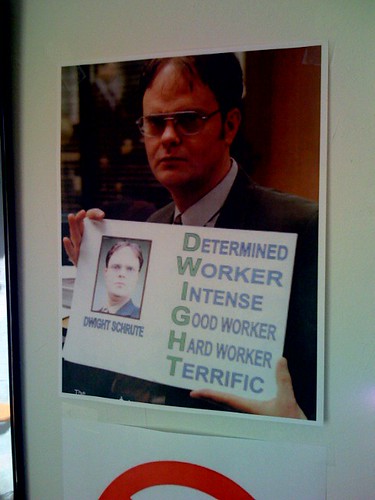Everyone has that coworker they’d rather walk on shattered glass than talk to. For the infamous greenhouse gas carbon dioxide, that coworker is water.

Much like Dwight from The Office, carbon dioxide has a vendetta against one of the most beloved workers in the office: water. Picture courtesy of Creative Commons.
Now I know what you’re thinking. Who doesn’t like water? Water is the source of all life; it’s a key component in so many things! Well, Carbon Dioxide, much like oil, is hydrophobic, meaning it will not readily mix or react with water. And truth be told, water isn’t particularly fond of carbon dioxide either.
Unfortunately for the two of them, their bosses, a team of chemists led by F. Pelayo García de Arquer, made them partners to produce two types of fuel: ethanol and ethylene.
Obviously, this didn’t work out at first, and the two refused to cooperate.
This led the research team to introduce a mediator to help move the job along: a copper-catalyst. Catalysts increase the rate of chemical reactions, and this copper-catalyst forced force water and carbon dioxide to finally put aside their differences.
Unlike carbon dioxide, the copper-catalyst is hydrophilic, meaning it readily absorbs and reacts with water. The copper-catalyst holds onto water’s protons, little nuggets of positively charged energy carbon dioxide needs in order to produce ethanol and ethylene. Thankfully, carbon dioxide finds the copper-catalyst to be a little more palatable than water and readily accepts these protons. Thus, the copper-catalyst acts as a bridge between the two, ensuring that none of them get into trouble with the boss for not doing their work.

85% ethanol car fuel. Picture courtesy of Creative Commons.
Despite two of its components constantly butting heads, this is a relatively simple and cost-effective process that produces high-demand fuels needed for automobiles. However, there are still a few tweaks to work out, such as what temperatures and environments carbon dioxide, water, and the copper-catalyst work best in.
Overall, this hesitant partnership has a lot of work to do, but Arquer and his team are optimistic that this reaction may soon lead the charge in the fight for renewable energy.
https://science.sciencemag.org/content/367/6478/661
García de Arquer F., Ding C., Ozden A., et. al. CO2 electrolysis to multicarbon products at activities greater than 1 A cm−2. Science 2020. Vol. 367, Issue 6478, pp. 661-666. DOI: 10.1126/science.aay4217

Alex
"This title was very eye catching! That is so interesting that such a ..."
Alex
"This is really interesting! The fact that crops and plants are damaged is ..."
Alex
"Well done, this article is great and the information is very captivating! Ethics ..."
Alex
"I was intrigued throughout the whole article! This is such an interesting topic, ..."
Alex
"This is such an interesting article, and very relevant!! Great job at explaining ..."
Grandpa
"Honey You Did a good job I will forward to my eye doctor "
murphymv
"This article is fascinating because it delves into the details of the research ..."
murphymv
"I agree, adding the photo helped solidify the main finding. "
murphymv
"This is a fascinating finding. I hope this innovative approach to improving transplants ..."
Sherzilla
"This is a great article! I would really love to hear how exactly ..."
Sherzilla
"It's disappointment that these treatments were not very effective but hopefully other researchers ..."
Sherzilla
"I agree with your idea that we need to shift our focus to ..."
Sherzilla
"It's amazing to see how such an everyday household product such as ..."
Lauren Kageler
"I will be interested to see what the data looks like from the ..."
Lauren Kageler
"A very interesting article that emphasizes one of the many benefits that the ..."
maricha
"Great post! I had known about the plight of Little Browns, but I ..."
Sherzilla
"I assumed cancer patients were more at risk to the virus but I ..."
Sherzilla
"Great article! It sheds light on a topic that everyone is curious about. ..."
maricha
"This article is full of really important and relevant information! I really liked ..."
maricha
"Definitely a very newsworthy article! Nice job explaining the structure of the virus ..."
maricha
"It's interesting to think that humans aren't only species dealing with the global ..."
murphymv
"This is very interesting and well explained. I am not too familiar with ..."
Lauren Kageler
"Great article! This post is sure to be a useful resource for any ..."
Lauren Kageler
"Definitely seems like an odd pairing at first, but any step forward in ..."
murphymv
"What an interesting article! As you say, height and dementia seem unrelated at ..."
murphymv
"Great article! I learned several new methods of wildlife tracking. This seems like ..."
murphymv
"Very interesting topic! You explained cascade testing and its importance very well. I ..."
Alex
"This article is really interesting! What got me hooked right away was the ..."
Sabrina
"I found this article super interesting! It’s crazy how everyday products can cause ..."
Erin Heeschen
"I love the layout of this article; it's very eyecatching! The advancements of prosthetics ..."
murphymv
"Awesome article! I like the personality in the writing. Flash Graphene not only ..."
murphymv
"Very interesting work! I don't know a whole lot about genetics, but this ..."
Cami Meckley
"I think the idea of using virtual reality technology to better help prepare ..."
Erin Heeschen
"I wonder if there's a connection between tourist season and wildfires in the ..."
Ralph berezan
"Not bad Good work "
Michelle
"This sounds like it would be a great tool for medical students! ..."